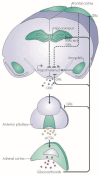Early Life Stress, Nicotinic Acetylcholine Receptors and Alcohol Use Disorders
- PMID: 26136145
- PMCID: PMC4588139
- DOI: 10.3390/brainsci5030258
Early Life Stress, Nicotinic Acetylcholine Receptors and Alcohol Use Disorders
Abstract
Stress is a major driving force in alcohol use disorders (AUDs). It influences how much one consumes, craving intensity and whether an abstinent individual will return to harmful alcohol consumption. We are most vulnerable to the effects of stress during early development, and exposure to multiple traumatic early life events dramatically increases the risk for AUDs. However, not everyone exposed to early life stress will develop an AUD. The mechanisms determining whether an individual's brain adapts and becomes resilient to the effects of stress or succumbs and is unable to cope with stress remain elusive. Emerging evidence suggests that neuroplastic changes in the nucleus accumbens (NAc) following early life stress underlie the development of AUDs. This review discusses the impact of early life stress on NAc structure and function, how these changes affect cholinergic signaling within the mesolimbic reward pathway and the role nicotinic acetylcholine receptors (nAChRs) play in this process. Understanding the neural pathways and mechanism determining stress resilience or susceptibility will improve our ability to identify individuals susceptible to developing AUDs, formulate cognitive interventions to prevent AUDs in susceptible individuals and to elucidate and enhance potential therapeutic targets, such as the nAChRs, for those struggling to overcome an AUD.
Keywords: Early life stress; GABA; alcohol; cholinergic; dopamine; mesolimbic; nicotinic acetylcholine receptors; nucleus accumbens; stress resilience.
Figures



Similar articles
-
Differential effects of nicotinic antagonists perfused into the nucleus accumbens or the ventral tegmental area on cocaine-induced dopamine release in the nucleus accumbens of mice.Psychopharmacology (Berl). 2007 Feb;190(2):189-99. doi: 10.1007/s00213-006-0598-6. Epub 2006 Oct 24. Psychopharmacology (Berl). 2007. PMID: 17061109
-
Neuronal nicotinic acetylcholine receptors as pharmacotherapeutic targets for the treatment of alcohol use disorders.CNS Neurol Disord Drug Targets. 2010 Mar;9(1):60-76. doi: 10.2174/187152710790966597. CNS Neurol Disord Drug Targets. 2010. PMID: 20201817 Free PMC article. Review.
-
Alcohol: mechanisms along the mesolimbic dopamine system.Prog Brain Res. 2014;211:201-33. doi: 10.1016/B978-0-444-63425-2.00009-X. Prog Brain Res. 2014. PMID: 24968782 Review.
-
Sex Specific Alterations in α4*Nicotinic Receptor Expression in the Nucleus Accumbens.Brain Sci. 2018 Apr 19;8(4):70. doi: 10.3390/brainsci8040070. Brain Sci. 2018. PMID: 29671814 Free PMC article.
-
Stress and alcohol: epidemiologic evidence.Alcohol Res. 2012;34(4):391-400. Alcohol Res. 2012. PMID: 23584105 Free PMC article. Review.
Cited by
-
Neuroimmune Interactions in Schizophrenia: Focus on Vagus Nerve Stimulation and Activation of the Alpha-7 Nicotinic Acetylcholine Receptor.Front Immunol. 2017 May 31;8:618. doi: 10.3389/fimmu.2017.00618. eCollection 2017. Front Immunol. 2017. PMID: 28620379 Free PMC article. Review.
-
Acceptance of Illness and Coping with Stress among Patients Undergoing Alcohol Addiction Therapy.J Clin Med. 2023 Jul 19;12(14):4767. doi: 10.3390/jcm12144767. J Clin Med. 2023. PMID: 37510882 Free PMC article.
-
The Risk Factors of the Alcohol Use Disorders-Through Review of Its Comorbidities.Front Neurosci. 2018 May 11;12:303. doi: 10.3389/fnins.2018.00303. eCollection 2018. Front Neurosci. 2018. PMID: 29867316 Free PMC article. Review.
-
Unravelling the Link Between Prenatal Stress, Dopamine and Substance Use Disorder.Neurotox Res. 2017 Jan;31(1):169-186. doi: 10.1007/s12640-016-9674-9. Epub 2016 Oct 24. Neurotox Res. 2017. PMID: 27778246 Review.
References
Publication types
LinkOut - more resources
Full Text Sources
Other Literature Sources

